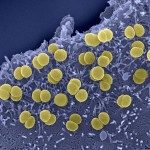Lien vers Pubmed [PMID] – 12867744
J. Mol. Microbiol. Biotechnol. 2003;5(4):206-15
Phosphorylation and dephosphorylation at Ser-46 in HPr, a phosphocarrier protein of the phosphoenolpyruvate:carbohydrate phosphotransferase system (PTS) is controlled by the bifunctional HPr kinase/phosphorylase (HprK/P). In Gram-positive bacteria, P-Ser-HPr controls (1) sugar uptake via the PTS; (2) catabolite control protein A (CcpA)-mediated carbon catabolite repression, and (3) inducer exclusion. Genome sequencing revealed that HprK/P is absent from Gram-negative enteric bacteria, but present in many other proteobacteria. These organisms also possess (1) HPr, the substrate for HprK/P; (2) enzyme I, which phosphorylates HPr at His-15, and (3) one or several enzymes IIA, which receive the phosphoryl group from P approximately His-HPr. The genes encoding the PTS proteins are often organized in an operon with HPRK. However, most of these organisms miss CcpA and a functional PTS, as enzymes IIB and membrane-integrated enzymes IIC seem to be absent. HprK/P and the rudimentary PTS phosphorylation cascade in Gram-negative bacteria must therefore carry out functions different from those in Gram-positive organisms. The gene organization in many HprK/P-containing Gram-negative bacteria as well as some preliminary experiments suggest that HprK/P might control transcription regulators implicated in cell adhesion and virulence. In alpha-proteobacteria, HPRK is located downstream of genes encoding a two-component system of the EnvZ/OmpR family. In several other proteobacteria, HPRK is organized in an operon together with genes from the RPON region of ESCHERICHIA COLI (RPON encodes a sigma54). We propose that HprK/P might control the phosphorylation state of HPr and EIIAs, which in turn could control the transcription regulators.

